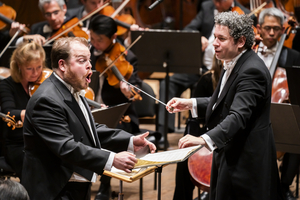Review: Gustavo Dudamel Leads DAS LIED with the NY Philharmonic at Geffen Hall
Last-minute substitute Andrew Staples and mezzo Michelle de Young excel

Photo: Chris Lee
Maestro Gustavo Dudamel, who usually leads the LA Philharmonic, took a busman's holiday to NY for a brace of performances with his orchestra's East Coast counterpart, the New York Philharmonic. His reputation as a master on the podium is not overrated: He runs the fine line between the clear, thoughtful maestro and one who adds fire to the mix.
I can't think of a more understated, yet fully controlled, performance than the one I heard Friday night at Lincoln Center's David Geffen Hall, with Schubert and, especially Mahler on the bill. There are not many pieces of music that send chills up my spine in the way the introduction to Mahler's DAS LIED VON DER ERDE does, especially when the maestro has an orchestra like the Philharmonic in tow.

Photo: Chris Lee
Long before I ever heard Mahler's live, I had been captivated by a famed recording with Fritz Wunderlich and Christa Ludwig, under conductor Otto Klemperer. In particular, it was the first of the songs--suggested by a collection of Chinese poems loosely translated into German--"Das Trinklied vom Jammer der Erde (The Drinking Song of Earthly Sorrow)" that captivated me, with its thrusting orchestration and powerful part for a tenor. Of course, the rest of the cycle, and the wonderful Ludwig, was pretty much a match, in their varied ways.
When I finally began hearing it performed in a concert hall, what surprised me most was that the tenor part had become a mainstay of heldentenors (the kind that sing Tristans, Siegfrieds, Parsifals and the like). My recording was done by Wunderlich, killed in an accident in his '30s, who was an elegant singer best known for his performances of Mozart and German art songs (lieder) though he did some less demanding roles in the Wagner repertoire (the steersman in FLYING DUTCHMAN, etc.).

Photo: Chris Lee
The performances at the Philharmonic were scheduled to feature Simon O'Neill, a studied ERDE-man and Wagnerian. (He did Act 1 of Wagner's WALKURE at the NY Philharmonic a few years back.) He fell ill at the last minute and his replacement was a tenor more in the Wunderlich manner, Andrew Staples, who had recently been appearing at the Met as the friend of the eponymous WOZZECK.
Now I'm quite aware about the difference between hearing a live performance and a recording, where the magic of recording devices (and the placement of a microphone) could be key to the power of the singers. So I was naturally I was concerned about how a less heroic voice would fare against DAS LIED's thundering orchestration.
I was happy to hear Staples put in an admirable performance, with only the first song something of a challenge in soaring over the orchestra. It was not because of his skills as a singer, but because Mahler made almost sadistic demands on even the largest of voices with his thick orchestration--unquestionably thrilling for the listener but certainly a major demand for the artist in pulling it off. Yet, Staples' elegant but bold approach made it clear that he had the kind of resources to do the piece without ever sounding like he was killing his voice in the process.
The tenor's partner in the cycle was mezzo Michelle de Young, who did a wonderful job from her first appearance in the cycle. While it's true that the orchestration in her songs was not as punishing as the tenor's "Das Trinklied...," the depth and breadth of the music she had to deal with was still unquestionably demanding and she handled them exceedingly well.
The last time the Philharmonic did the piece was 2016, conducted by Alan Gilbert, and it used Mahler's alternate configuration of tenor and baritone, with Thomas Hampson filling the second slot. (Those who have always thought tenor Jonas Kaufmann's sound as baritonal, should know that, in his recording of DAS LIED, he sings both parts.)
Hampson took an elegant tack, making up for his lack of volume with a more cerebral approach and made it work wonderfully. Nonetheless, de Young showed off her big, striking mezzo and vocal prowess to make one think it couldn't possibly be done any other way. Whether in the largest sound, over the sections of thick orchestration of "Von der Schonheit (Of Beauty)" to the most intimate in the final "Ewig...ewig [Forever...forever]," she sang in the most marvelous way.
Mahler called the piece DAS LIED VON DER ERDE rather than making it a numbered symphony, supposedly trying to "trick death." He "subscribed to the superstition," according to the program notes, that composers didn't survive past their ninth symphonies. For me, whatever you call it, DAS LIED is a pretty good substitute, perhaps my favorite Mahler. As for tricking death, well, he did, kinda. He survived to write a real Ninth Symphony and part of a Tenth: but he never lived to hear DAS LIED performed.
Before the Mahler work took over the stage, the concert's opener was Schubert's Fourth Symphony, an eclectic and modest work, filled with sudden crescendos, echoes of Mozart and Beethoven and wonderful solo work for the winds and brass.
Dudamel was smart enough not to blow this one up to "poster size" and let the piece exist on its own terms, from elegant to tympanaic. The writing for the winds and horns--not to mention that tympani--showed that every piece doesn't have to be a blockbuster to give pleasure, as Dudamel and the players of the Philharmonic certainly did with the Schubert.
Add Your Comment
Videos

